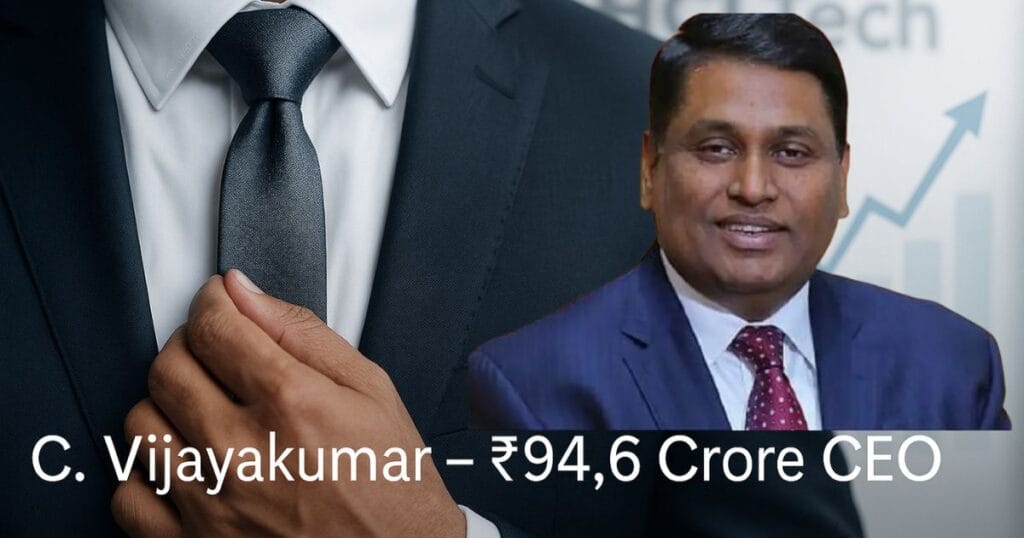In the Indian IT industry, one name has once again made headlines — C. Vijayakumar, the CEO of HCLTech. In the financial year 2024-25 (FY25), he received a total pay package of ₹94.6 crore (about $10.85 million), making him the highest paid CEO in India’s IT sector for the second consecutive year.

The biggest portion of this hefty package came from Long Term Incentives (LTI) — a performance-linked bonus given in the form of company shares, which can be availed over several years.
C. Vijayakumar’s Salary Package — Complete Breakdown
According to the company’s annual report, his FY25 compensation was as follows.
- Base Salary: $1.96 million (~₹17.1 crore) — fixed annual pay.
- Variable Bonus: $1.73 million (~₹15.1 crore) — performance-based bonus linked to company and CEO results.
- LTI / Stock Incentives: $6.96 million (~₹60.7 crore) — company shares and stock options, vested over a period.
- Other Benefits: $0.2 million (~₹1.7 crore) — includes retirement benefits and perks.
This package represents a 7.9% increase compared to last year.
What is LTI and Why is it Important?
LTI (Long Term Incentive) is a performance reward given in the form of company shares or stock options. The CEO C. Vijayakumar doesn’t get it as cash immediately; instead, it is granted over a set “vesting period” — typically 3-4 years — and depends on company performance.
In FY25, Vijayakumar was granted 150,000 Restricted Stock Units (RSUs) at an average value of $46.4 per share.
As per the company’s vesting schedule:
- Year 1: 33% of shares
- Year 2: 33% of shares
- Year 3: 34% of shares
This structure ensures the CEO’s interest remains tied to the company’s long-term growth.
How C. Vijayakumar Compares with Other Indian IT CEOs
| CEO | Company | FY25 Pay (₹ crore) | Key Notes |
|---|---|---|---|
| C. Vijayakumar | HCLTech | 94.6 | Large LTI portion (64%), 6.5% company growth |
| Salil Parekh | Infosys | 80.62 | Growth from stock options, but lower total pay |
| Srini Pallia | Wipro | 53.64 | Higher variable pay, lower LTI |
| K. Krithivasan | TCS | 26.52 | Stable pay, Tata Group’s conservative policy |
HCLTech’s Performance — Does the Pay Justify?
Yes, the numbers suggest it does. In FY25, HCLTech reported:
- Revenue: ₹1,17,055 crore (6.5% YoY growth)
- Net Profit: ₹15,702 crore (5.7% YoY growth)
- Market Cap: ₹4.4 lakh crore (20% YoY rise)
- New Large Clients: 66 (each with $100M+ annual contracts)
- Total Contract Value (TCV): $9.3 billion
The company also closed a mega deal with Verizon and made strong moves in AI/GenAI projects.
CEO Pay Ratio and the Debate Around It
In FY25, C. Vijayakumar’s pay was 662.5 times higher than the median HCLTech employee salary. In FY24, this ratio was 707:1, indicating a slight improvement.
The debate has two sides:
- Such a large pay gap may affect employee morale and increase perceptions of inequality.
- Performance-based rewards can motivate leadership to deliver sustained growth.
Market and Investor Reaction
The disclosure in August 2025 didn’t trigger any significant market drop. HCLTech’s stock remained stable between ₹1,550 and ₹1,600, even showing a slight uptick. Brokerages like HDFC Securities commented that the “pay is justified given the company’s growth trajectory.”
C. Vijayakumar Wikipedia
Outlier or Industry Trend?
Indian IT sector CEO salaries have been rising steadily over the past few years, mainly driven by LTIs. In 2020, the average Indian IT CEO salary was ₹6.9 crore, which rose to ₹9.3 crore in 2024 — a jump of around 35%. While still behind global peers, India is narrowing the gap.
Taxes, Policies, and Social Impact
- Taxes: On ₹94.6 crore, about ₹38 crore would go in income tax.
- Policy Discussions: SEBI has been exploring caps on executive pay.
- Social Impact: Such high pay can widen income inequality but also drive innovation and business performance.
ALSO READ- Artificial Intelligence and the Future of Jobs: Challenges, Opportunities, and Preparation Strategies
Does C. Vijayakumar actually get the full ₹94.6 crore in cash?
No — only a part of it is cash. Around one-third (base salary + variable bonus) comes as direct cash. The larger share, nearly 64%, is in the form of company stocks (LTI), which he will receive over the next few years depending on HCLTech’s performance.
Why is his salary so much higher than most other IT CEOs in India?
The main reason is the size of his Long Term Incentive (LTI) package. HCLTech links a big chunk of the CEO’s pay to company performance and share price growth. This year, the company’s revenue, profit, and market cap all went up, so his LTI value also increased.
Does such a high CEO salary affect normal employees?
It can. A big pay gap may sometimes cause frustration among employees, but it can also be a sign that the company is rewarding performance at the top level. HCLTech says it gives average employees an annual pay hike of around 7%, even while offering high performance-linked rewards to leadership.
Conclusion — A Changing Reward Model in Indian IT
C. Vijayakumar’s case shows that India’s IT sector is shifting towards a performance-heavy, LTI-driven compensation model. CEO earnings are now more directly tied to company growth, shareholder value, and long-term strategy — not just fixed salaries. This trend is likely to grow stronger, rewarding leadership for sustained results rather than short-term wins.


